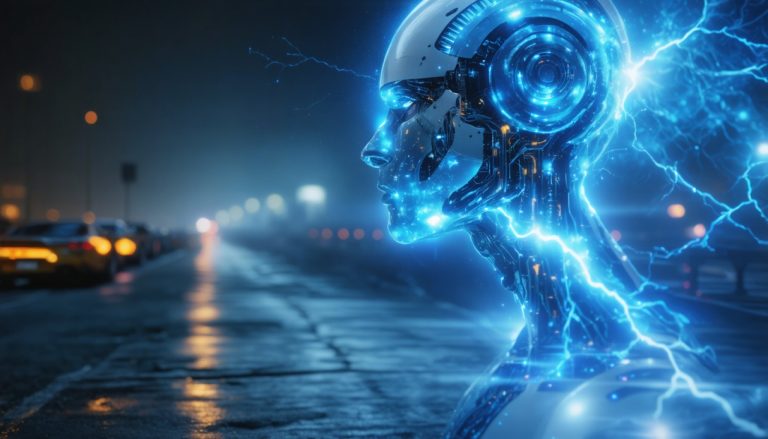
- Jensen Huang, CEO of Nvidia, transformed from an immigrant in America to a pivotal leader in technology, showcasing resilience and vision.
- Nvidia was founded in 1993, focusing on GPUs for gaming, which later fueled advancements in AI and transformed industries beyond gaming.
- Nvidia’s chips underpin AI applications like OpenAI’s ChatGPT, reshaping human-machine interaction possibilities.
- Nvidia faces competition from China’s DeepSeek, which developed an AI chatbot using fewer advanced chips, challenging Nvidia’s market dominance.
- Jensen Huang’s leadership exemplifies the importance of adaptability and foresight in navigating technology’s rapid evolution.
- The story highlights how resilience and innovation can create value amidst challenges and redefine industry standards.
Amid the ever-shifting landscape of technology, where microchips and artificial intelligence reign supreme, one man stands as a towering figure: Jensen Huang, the CEO of Nvidia. His journey from a humble immigrant to the architect behind the world’s most sought-after microchips is a riveting tale of vision, ambition, and adaptation.
Picture this—a young boy, just ten years old, arriving in America from the vibrant heartlands of Thailand. Jensen Huang didn’t just adapt to a new culture; he thrived in it. Residing in Oregon, he balanced the rigors of schoolwork and late shifts at Denny’s with an unlikely passion—competitive Ping-Pong, where he competed nationally, revealing traces of a relentless drive that would characterize his illustrious career.
Fast forward to the early ‘90s, a revolutionary era when games like “Myst” and “Doom” were captivating millions and personal computing started to gain momentum. Many tech enthusiasts sought to leave their mark, yet it was Huang who envisioned a different path. He saw the future in vibrant, immersive graphics and founded Nvidia in 1993, a bold start-up in the nascent field of video game graphics. Rather than challenge colossal players like Intel and Sun Microsystems head-on, his company zeroed in on a niche—developing graphics processing units (GPUs) tailored for gaming’s flourish.
In a twist unforeseen by many, the GPUs crafted by Nvidia did not just revolutionize gaming. Their computational power laid the foundation for groundbreaking advancements in AI, transforming industries beyond gaming. Under Huang’s leadership, Nvidia’s chips became the engine that powered artificial intelligence applications like OpenAI’s ChatGPT, reshaping the possibilities of human-machine interaction.
Despite Nvidia’s meteoric rise, recent times have tested its dominion. A new player from China, DeepSeek, has emerged, creating an AI chatbot that rivals ChatGPT, yet does so with remarkably fewer advanced chips. Nvidia, long perceived as indispensable, faced challenges under the weight of this cost-efficient innovation. When the news reached the markets, Nvidia’s stock faltered, proving even giants must remain nimble in tech’s relentless race.
Yet, what sets Nvidia—and indeed Huang—apart is resilience. The narrative is not merely about technology but also the human capacity to forge forward amidst upheaval. It is a tale of seeing possibilities where others see barriers, of creating value from challenges, and of the boundless power of innovation when led by visionaries.
The takeaway: In the world of technology, where today’s marvels quickly become yesterday’s news, success lies not only in crafting groundbreaking products but in anticipating the future’s twists and turns with unyielding vision. Jensen Huang embodies this ethos, propelling Nvidia to the forefront of a dynamic industry where adaptability is as crucial as invention. As the digital horizon expands evermore, Nvidia’s journey continues to inspire, reflecting the incredible potential that innovation and resilience hold to reshape reality.
Nvidia’s Unyielding Journey into the Future of AI and Graphics
In the dynamic realm of technology, few stories captivate like that of Jensen Huang and Nvidia. Huang’s tale is one of vision and adaptation, having transformed Nvidia from a scrappy startup into a titan at the heart of modern computing. Let’s explore deeper into Nvidia’s strategies, challenges, and prospects, unveiling more layers of this fascinating story.
Nvidia: Pioneering Beyond Gaming Graphics
Expanded Impact of GPUs:
Nvidia’s graphics processing units, originally designed to serve gamers, have found pivotal uses beyond gaming. Their ability to perform parallel calculations allows them to process immense amounts of data swiftly, making them ideal for AI applications, such as training machine learning models. The GPUs also play significant roles in sectors like automotive, health care, and crypto mining, thus spreading Nvidia’s influence across various industries.
Real-World Use Cases:
– Automotive Sector: Nvidia’s DRIVE platform powers the future of autonomous vehicles, providing the hardware and software required for self-driving capabilities.
– Health Care: Nvidia’s GPUs accelerate the development of AI models that can enhance medical imaging and the early diagnosis of diseases.
– Cryptocurrency Mining: Despite some fluctuations, Nvidia’s GPUs are extensively used in cryptocurrency mining, though this has led to challenges such as GPU shortages.
Market Forecasts and Industry Trends
AI and Machine Learning Growth:
The global AI market is projected to grow significantly, with estimates suggesting it could reach $190.61 billion by 2025 (MarketsandMarkets). Nvidia’s role in this market is expected to expand as AI increasingly relies on sophisticated hardware solutions.
Emergence of Competitors:
With the rise of companies like DeepSeek offering more cost-effective solutions, Nvidia faces a competitive landscape that demands continuous innovation.
Challenges and Opportunities
Controversies and Limitations:
– Environmental Impact: The environmental impact of manufacturing high-performance GPUs is a growing concern, prompting Nvidia to explore sustainable practices.
– Ethical Use of AI: Nvidia must navigate the ethical implications of AI technology, ensuring responsible use and avoiding potential biases inherent in AI systems.
Security and Sustainability:
Nvidia has been investing in making its technology more secure and sustainable. By working on reducing carbon footprints and improving energy efficiency, Nvidia responds to modern customer and regulatory demands.
Insights and Predictions
Pros and Cons Overview:
– Pros: High-performance computing capabilities, leading innovations in AI, and adaptability.
– Cons: High costs, environmental concerns, and increasing competitive pressure.
Actionable Recommendations
1. For Tech Enthusiasts: Keep abreast of Nvidia’s latest developments, particularly in emerging AI fields, as their GPUs continue to power breakthrough innovations.
2. For Investors: Monitor Nvidia’s response to new competitors and market demands; smart investments will consider Nvidia’s long-term vision and adaptability.
3. For Gamers and Professionals: Explore Nvidia’s range of products tailored to your computing needs, whether for gaming, professional rendering, or AI development.
In conclusion, as Nvidia navigates the challenges and opportunities of an ever-evolving tech landscape, its journey remains a testament to the profound impact of innovation and resilience. Staying informed about Nvidia’s strategies and market shifts will provide valuable insights into the future of technology. For more information, visit the official Nvidia website.



